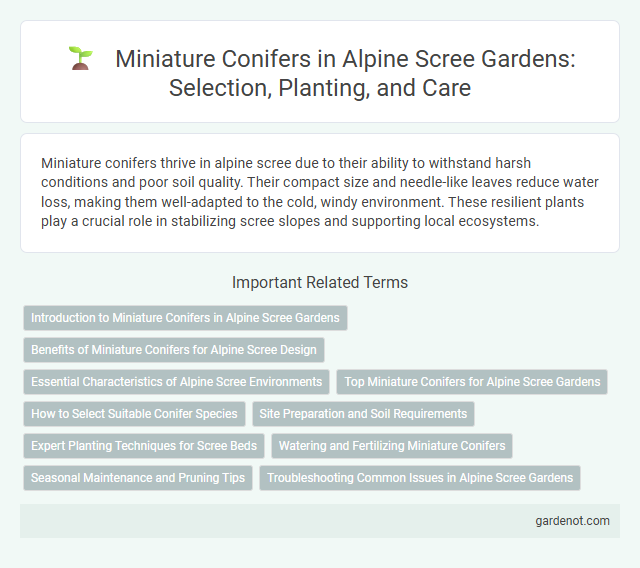Miniature conifers thrive in alpine scree due to their ability to withstand harsh conditions and poor soil quality. Their compact size and needle-like leaves reduce water loss, making them well-adapted to the cold, windy environment. These resilient plants play a crucial role in stabilizing scree slopes and supporting local ecosystems.
Introduction to Miniature Conifers in Alpine Scree Gardens
Miniature conifers in alpine scree gardens exhibit exceptional adaptability to harsh, rocky environments, thriving in well-drained, nutrient-poor soils with minimal moisture retention. Species such as dwarf pines (Pinus mugo var. pumilio) and creeping junipers (Juniperus horizontalis) are prized for their compact growth habit and resilience to cold, wind, and temperature fluctuations typical of alpine scree habitats. Their slow growth and evergreen foliage provide year-round structure and contrast, enhancing the visual appeal and ecological stability of alpine scree landscapes.
Benefits of Miniature Conifers for Alpine Scree Design
Miniature conifers enhance alpine scree design by providing year-round greenery and structural contrast to rocky, well-drained soils. Their shallow root systems stabilize loose scree, reducing erosion and promoting soil retention in harsh mountain environments. Compact growth habits and drought tolerance make miniature conifers ideal for sustainable, low-maintenance alpine landscaping.
Essential Characteristics of Alpine Scree Environments
Miniature conifers in alpine scree environments exhibit remarkable adaptability to extreme conditions, including poor soil nutrients, high wind exposure, and intense temperature fluctuations. Their compact growth form and deep root systems enable stability on unstable, rocky substrates and efficient moisture retention. These essential characteristics support survival and reproduction in the challenging microhabitats of alpine scree slopes.
Top Miniature Conifers for Alpine Scree Gardens
Top miniature conifers for alpine scree gardens include dwarf varieties such as Pinus mugo 'Pumilio', known for its compact, dense foliage and tolerance to rocky, well-drained soils. These miniature pines, alongside Picea glauca 'Conica' and Juniperus communis 'Depressa', offer vibrant green hues and resilient growth in harsh mountainous environments. Their low-growing, slow-spreading nature makes them ideal for stabilizing scree slopes while enhancing the visual texture of alpine garden landscapes.
How to Select Suitable Conifer Species
Selecting suitable miniature conifer species for alpine scree requires prioritizing cold hardiness and drought tolerance to withstand harsh mountain climates. Compact growth forms like Dwarf Alberta Spruce (Picea glauca 'Conica') and creeping Juniper (Juniperus horizontalis) are ideal for stability on loose scree slopes. Evaluate rooting depth and soil drainage preferences to ensure species adapt well to rocky, nutrient-poor substrates common in alpine scree environments.
Site Preparation and Soil Requirements
Miniature conifers thrive on well-drained, acidic to neutral soils typical of alpine scree environments, requiring minimal organic matter and excellent aeration for root development. Site preparation involves clearing loose debris and ensuring stable substrate to prevent erosion, allowing the shallow root systems to anchor securely. Optimal growth occurs in rocky, nutrient-poor conditions with full sun exposure and protection from wind desiccation.
Expert Planting Techniques for Scree Beds
Miniature conifers thrive in alpine scree beds when planted with precise techniques emphasizing soil drainage, proper spacing, and root protection. Experts recommend using rocky, well-drained substrates mimicking natural scree environments to prevent waterlogging and encourage healthy root development. Strategic placement with adequate sunlight exposure and wind shelter enhances the miniature conifer's growth and resilience in harsh alpine conditions.
Watering and Fertilizing Miniature Conifers
Miniature conifers in alpine scree environments require careful watering to prevent root rot while maintaining consistent moisture during the growing season. Fertilize with a balanced, slow-release formula rich in nitrogen, phosphorus, and potassium in early spring to support healthy growth and resilience. Avoid over-fertilizing, which can damage delicate roots and disrupt the natural mineral balance of the alpine scree substrate.
Seasonal Maintenance and Pruning Tips
Miniature conifers in alpine scree require seasonal maintenance to thrive, with spring being the ideal time for pruning to remove dead or damaged branches and promote healthy growth. Avoid heavy pruning during late summer and fall to prevent new growth vulnerable to winter damage. Regularly inspect for pests and ensure proper drainage to maintain the miniature conifer's vigor in its rocky, well-drained environment.
Troubleshooting Common Issues in Alpine Scree Gardens
Miniature conifers in alpine scree gardens often face water drainage problems due to the fast-draining soil composition, leading to root dehydration or rot. Ensuring proper soil mix with adequate moisture retention while maintaining sharp drainage can prevent stress and fungal infections. Regular monitoring for pest infestations such as aphids or spider mites is essential to maintain plant health in harsh alpine conditions.
Miniature conifer Infographic

 gardenot.com
gardenot.com